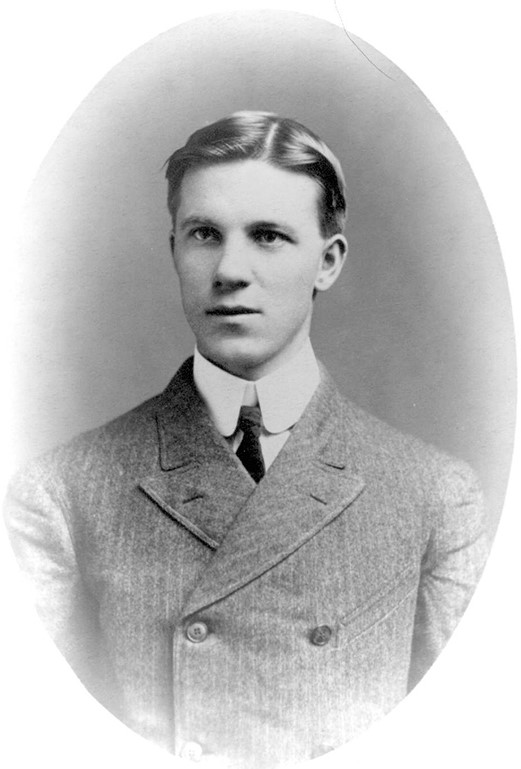FURNAS-CHARLES
CHARLES WILLIAM "CHARLEY" FURNAS

MECHANICS MATE

Excerpts from article published in May 2017 issue of Smithsonian Air & Space Museum Magazine, authored by Matthew Browne:
THE FIRST AIRPLANE PASSENGER
Just before 8 A.M. on May 14, 1908, Wilbur Wright made an easy landing on the beach at Kitty Hawk. He had covered about 2,000 feet in just over 28 seconds, figures that by this point in his career were routine, even underwhelming. But it was still a flight for the record books. For the first time, one of the Wrights had taken a second person aboard one of their wood and fabric machines. That man was Charles William Furnas.
Charley, as friends knew him, was born in 1880 in West Milton, Ohio, on the outskirts of the Wrights’ hometown, Dayton. In 1902 Charles joined the Navy, hoping to gain mechanical experience. After serving four years as a mechanic’s mate, he got an honorable discharge and returned to Dayton to put his skills to work. By 1908 he was working for a Dayton machinist within walking distance of the Wright bicycle shop. According to Wilbur’s diaries, Charley had observed some of the Wrights’ flying tests at Huffman Prairie in November 1904, likely while he was on Thanksgiving leave from the Navy. The Wrights were famous men by 1908. Charley was one of their most enthusiastic fans, and he could barely contain his excitement at working just down the street from them. He made frequent visits to their shop, pestering the brothers to teach him about flying while offering labor in exchange. Eventually, the Wrights allowed Charles to assist their full-time mechanic on various odd jobs.
On April 11, 1908, Charley received his first paycheck from the Wright organization. He’d begun working for the brothers just as they succeeded in selling an airplane to the U.S. Army which was contingent upon the airplane’s capability to carry a passenger. Most of Charley’s work was likely modifying their 1905 machine, the Flyer III, which would become the first capable of carrying a passenger. When the new machine was complete, Wilbur left for Kitty Hawk in early April with Orville slated to join him at the end of the month. Wilbur received a big surprise, recorded in his diary on April 15, 1908. “Toward noon we saw a man over at camp. I thought it might be one of the carpenters and went over to see what he wanted. Was very much surprised to find it was Charley Furnas from Dayton.” Uninvited and unannounced, Charley had traveled from Dayton, more than 650 miles, just to be there for the flight. Wilbur didn’t have the funds to pay Charley, but Charley couldn’t have arrived at a time when Wilbur needed more help. Charley was put in charge of rebuilding the Wrights’ camp.
By the end of April, Orville and Wilbur were making solo hops in the Flyer III with a sandbag in the second spot to approximate the extra weight. They famously vowed never to fly together, in part so that in case of an accident, one of the brothers could continue their experiments. By mid-May, the Wrights had developed enough confidence in the Flyer III to take up a passenger. They bestowed that honor upon Charley. On May 14, Wilbur took Charley for a flight of about 800 feet. That same day Orville flew Charley a distance of two miles, making him not only the first airplane passenger, but one of the very few who could claim to have flown with both of the Wright brothers. Days later, Wilbur headed to France to fly demonstrations and Orville left for Dayton to prepare for the presentations to the Army, with Charley in tow. In the months between Kitty Hawk and the Signal Corps demonstrations, Charley at last became a full-time employee of the Wrights.
On September 17, 1908, Orville took a young Army lieutenant as a passenger during a demonstration flight for the Signal Corps. The flight ended in a dramatic crash landing. Orville sustained serious injuries and the Army lieutenant later died from a fractured skull. Charley was one of the first people to rush out to sort through the damage. Charley returned to Dayton and quickly cut professional ties with the Wrights. There’s no record of why he quit, perhaps it was the strain of witnessing the lieutenant’s death. He returned to West Milton and stayed there for the rest of his life, opening his own garage, getting married, and buying a movie theater that ran early talkies. Although history would seldom recall his name, when Charley passed away on October 16, 1941, his funeral drew the attendance of at least one famous friend, Orville Wright. Charley’s dedication to machines and flying made him give four years to the Navy, and hundreds of hours of unpaid work and hundreds of miles of unpaid travel to the Wrights. Given his obsession with a pursuit that had eluded humankind for centuries, perhaps becoming a literal passenger to history is a fitting legacy.
NOTES: Charles William Furnas aviation firsts include (1) first airplane passenger, (2) first on-board flight engineer, (3) helped to develop and build the first military aircraft, (4) first person hired in America by an aircraft manufacturing firm when he became an employee of Wright Cycle Company expressly to build airplanes. The Wright Flyer III, in which Charley rode, was restored to its original configuration and is on display at Carillon Park in Dayton, Ohio.
Submitted by CDR Roy A. Mosteller, USNR (Ret)

